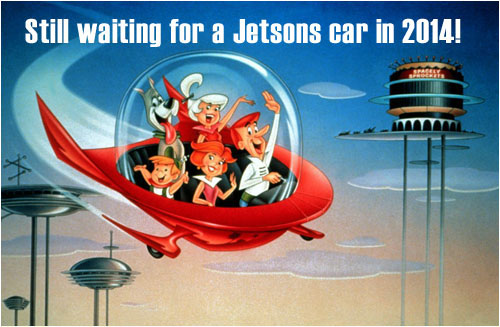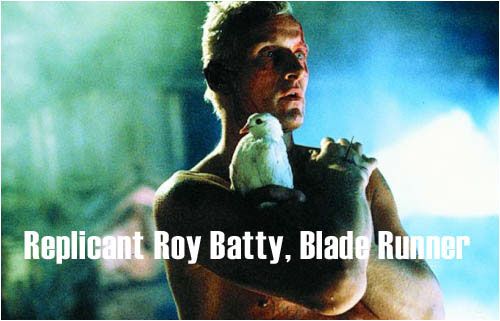I'm
currently awaiting a revision letter for my new contemporary
young adult book, The
Sweetest Thing You Can Sing, and getting ready to leave
the future behind me, at least for now (science fiction
is far too captivating for me to make the goodbye permanent!).
As you can see, I made a few cosmetic changes to the website
to reflect the return to contemporary fiction. But before
I completely leave 2063 and the U.N.A. in my wake, I wanted
to discuss some of the science behind Yesterday
and Tomorrow.
Many of the forces that define the North America of 2063
in Yesterday
and Tomorrow —
global warming, nano-medicine, the ubiquitous presence of
full immersion virtual reality, and the widespread replacing
of human workers with robots or other technologies —
are highly possible given where we stand today. As the rate
of technological change and climate change increases, we're
in for a wild ride.
 Growing up in the 70s and 80s, by the twenty-first
century I expected many changes that haven't come to pass
— flying cars, much more extensive space exploration
than humanity has actually accomplished, sophisticated robots
(or should I say Replicants?), and cures for countless deadly
diseases that still plague us. Meanwhile things I never
expected have either greatly impacted our daily lives or
loom large just around the corner. I'm chiefly talking about
two things — how intertwined our "real" lives
have become with the Internet and other technologies, and
the enormous threat climate change presents to most living
things on our planet. Bizarrely, even now that the threat
is well recognized, we've barely begun to respond to the
problem, and procrastination will only make our future direr.
Growing up in the 70s and 80s, by the twenty-first
century I expected many changes that haven't come to pass
— flying cars, much more extensive space exploration
than humanity has actually accomplished, sophisticated robots
(or should I say Replicants?), and cures for countless deadly
diseases that still plague us. Meanwhile things I never
expected have either greatly impacted our daily lives or
loom large just around the corner. I'm chiefly talking about
two things — how intertwined our "real" lives
have become with the Internet and other technologies, and
the enormous threat climate change presents to most living
things on our planet. Bizarrely, even now that the threat
is well recognized, we've barely begun to respond to the
problem, and procrastination will only make our future direr.
CLIMATE CHANGE
In March the Nobel Peace Prize-winning Intergovernmental
Panel on Climate Change will issue a report on global warming.
A
draft of that report was leaked in November 2013 and
stated that, "Many of the ills of the modern world
- starvation, poverty, flooding, heat waves, droughts, war
and disease - are likely to worsen as the world warms."
"Throughout the 21st century, climate change impacts will slow down economic growth and poverty reduction, further erode food security and trigger new poverty traps, the latter particularly in urban areas and emerging hotspots of hunger. Climate change will exacerbate poverty in low- and lower-middle income countries and create new poverty pockets in upper-middle to high-income countries with increasing inequality."
A
recent University of Hawaii study projects that world
temperatures will be off the charts hot come 2047, with
various cities reaching the boiling point much sooner. Kingston
Jamaica will be likely be permanently off-the-charts hot
in just a decade with Singapore following in 2028, Mexico
City in 2031, Cairo in 2036, Phoenix and Honolulu in 2043,
San Diego and Orlando, Florida in 2046 and New York and
Washington in 2047.
According to study author Camilo Mora, "the 2047 date for the whole world is based on continually increasing emissions of greenhouse gases from the burning of coal, oil and natural gases. If the world manages to reduce its emissions of carbon dioxide and other gases, that would be pushed to as late as 2069. But for now, the world is rushing toward the 2047 date."
According to study author Camilo Mora, "the 2047 date for the whole world is based on continually increasing emissions of greenhouse gases from the burning of coal, oil and natural gases. If the world manages to reduce its emissions of carbon dioxide and other gases, that would be pushed to as late as 2069. But for now, the world is rushing toward the 2047 date."
ROBOTS
We could call it the next industrial revolution and it's already under way. You can see it in stores and airports in the form of self-check-in/out terminals, in Amazon's Kiva warehouse robots, machine driven commuter transport like Vancouver's Skytrain, and the imminent closing of most London tube system ticket offices in favour of direct payment via contactless bank cards. Google has "just purchased Boston Dynamics, a company known for building walking robots for the military" and says "it wants to build a robotic army for the manufacturing sector."

Google and numerous car manufacturing companies have been working on self-drive car technology. "Rice University computer science professor Moshe Vardi says that in 25 years "driving by people will look quaint; it will look like a horse and buggy. So there go many of the approximately 4 million driving jobs out there. Same for sanitation, and those are just a couple examples of how physical jobs will be replaced."
A recent report from the Oxford Martin School's Programme on the Impacts of Future Technology concludes that 45% of American jobs are at high risk of being taken by computers within the next two decades. The authors of the study "believe this takeover will happen in two stages. First, computers will start replacing people in especially vulnerable fields like transportation/logistics, production labor, and administrative support. Jobs in services, sales, and construction may also be lost in this first stage. Then, the rate of replacement will slow down due to bottlenecks in harder-to-automate fields such as engineering. This 'technological plateau' will be followed by a second wave of computerization, dependent upon the development of good artificial intelligence. This could next put jobs in management, science and engineering, and the arts at risk."
VIRTUAL REALITY
Most of us already spend quite a bit of time
in an alternate reality known as the Internet, or immersed
in increasingly realistic videogames.
According to eMarketer's estimate of media consumption among U.S. adults, average time spent with digital media per day was set to surpass TV viewing time for the first time in 2013. "The average adult will spend over 5 hours per day online, on nonvoice mobile activities or with other digital media this year, eMarketer estimates, compared to 4 hours and 31 minutes watching television."
Because eMarketer estimates all time spent within each medium (for example if someone spends an hour watching TV while also multitasking on a tablet, the time would be counted as spending an hour with TV AND an additional hour on mobile) the overall figures are sky high. U.S. adults spent an average of 11 hours and 49 minutes with media each day in 2012, and were forecast to spend 12 hours and 5 minutes with media in 2013.
In terms of gaming, full-body virtual reality has arrived with Virtuix Omni and virtual reality headset Oculus Rift. Palmer Luckey, Oculus' founder, says, "I think in a few years, maybe a few decades depending on how lucky we are, we'll be able to get Matrix level virtual."
Given the above info, inventor and futurist, Ray Kurzweil's belief that, "by the early 2020s we will be routinely working and playing with each other in full immersion visual-auditory virtual environments. By the 2030s, we will add the tactile sense to full immersion virtual reality" doesn't sound at all far-fetched.
Kurzweil posits that, "There will be limited ways of adding the tactile sense to virtual and augmented reality by the early 2020s, but full immersion virtual tactile experiences will require tapping directly into the nervous system. We'll be able to do that in the 2030s with nanobots traveling noninvasively into the brain through the capillaries and augmenting the signals coming from our real senses."
NANO-MEDICINE
Kurzweil also says, "in
30 or 40 years, we'll have microscopic machines traveling
through our bodies, repairing damaged cells and organs,
effectively wiping out diseases. The nanotechnology will
also be used to back up our memories and personalities...The
full realization of nanobots will basically eliminate biological
disease and aging."
We have a ways to go before reaching that Star Trek level of healing but clear progress is being made. "Scientists at the Massachusetts Institute of Technology have designed nanoparticles to target artery walls around the heart and release small quantities of drugs on a timed basis decided upon by a doctor beforehand."
"South Korean scientists are developing a new treatment for cancer that will be more efficient and less harmful than chemotherapy. A team at Chonnam National University has developed nanorobots that can detect and treat cancer cells in a way that avoids the harmful side-effects of modern drugs." Imagine, no more chemotherapy!
So if you were ever curious about where my ideas for 2063 U.N.A. society came from — here are the roots of the Bio-Net, gushi, robots workers creating mass human unemployment, and climate chaos rendering areas of North America almost uninhabitable. Roots that are firmly planted in the world of today.






